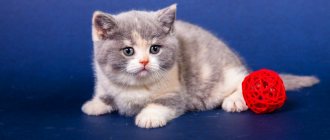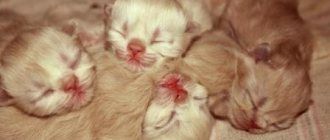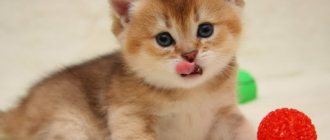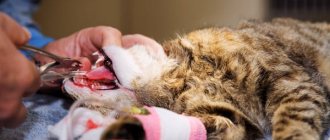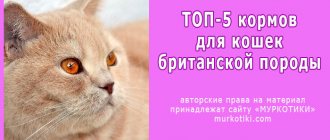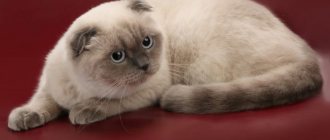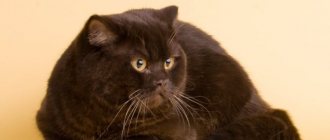BRITISH TABBY: COLOR STANDARD
British tabbies, regardless of the pattern on the coat, must have the following elements in their color (the exception is the ticked color - it has no pattern):
- the letter "M" on the forehead;
- “necklaces” on the chest;
- stripes on the paws;
- tail rings;
- one or two rows of spots on the belly;
- A contrasting tabby pattern is required;
- a light spot on each ear on the outside;
- eyeliner and nose to match the main color.
Photo: British spotted tabby cat, spotted chocolate color BRI b 24
British tabby color is based on a good contrast pattern; if it is blurred, it is rejected by experts. Most likely there was an incorrect mating, where one of the parents was a solid color and the other was a tabby.
The eye color of a British cat must correspond to the standard of the main color (most often golden, less often green or blue).
Cat colors: what are they and how are they bred?
The color of a cat implies not only the color of its fur, but also the pattern on it (spots, rings, stripes, stains, etc.). There are only a few main genes responsible for cat colors (solid color, diluents, etc.), but they can be made in a variety of combinations, like a children's construction set. This allows you to create countless options for breeding the desired trait, wisely using a set of parental genes (dominant and recessive).
The pattern on a cat's skin may vary
BRITISH SHORTHAIR TABBY CAT: VARIETIES OF COLOR PATTERNS
Shorthair British tabby cat, may be one of the following color subspecies:
- ticked;
- spotted (leopard);
- striped (brindle);
- marble.
Let's look at all types of colors schematically.
TICKED BRITISH COLOR
The ticked color of the British cats is similar in appearance to the solid color, although it belongs to the Tibby color of British cats. The color should be even and only the upper part should look like “spraying”.
By spreading the fur, you can see that each hair has stripes. The undercoat corresponds to the color of the coat (chocolate, blue, lilac, etc.).
Of all the tabby markings in the ticked color of a British cat, only the letter “M” is present on the forehead and drawn curls on the cheeks. All other stripes, spots, rings on the tail and “necklaces” on the chest are rejected.
This color is very similar to the shaded and veiled one, only it has a higher intensity of the main color. Eyes are orange, golden or green.
Photo: golden ticked British tabby kitten BRI ny 25 64
The main thing is love and affection
Cats of this breed are very sensitive and vulnerable. They definitely need to be petted, otherwise they get offended and worried. Simply feeding is clearly not enough. You need to take her in your arms and say kind words. They feel everything. Sometimes, even too much.
However, these cats will never impose themselves and get in the way
The owner himself must take the initiative and show attention to the pet.
Tabbies are very friendly and trusting. This breed is an excellent choice for families with small children. Cats will patiently endure any treatment from their little owners and will never show even a shadow of aggression towards them, not to mention extending their claws.
Representatives of this breed get along well with other pets. They can make excellent friends even with a pet rat, hamster or parrot, if there are any in the house.
SPOTTED TABBY, LEOPARD COLOR BRITISH
According to the standard, the spotted color of the British must contain the letter “M” on the forehead, “necklaces”, stripes on the paws, rings on the tail, spots on the belly, a contrasting pattern, eyeliner and nose.
The British spotted cat can also be called Spotted tabby or leopard, which, in principle, is the same thing. The color must invariably include: the letter “M” on the forehead, “necklaces”, stripes on the paws, rings on the tail, spots on the belly, a contrasting pattern, eyeliner and nose, all according to the standard. The spotted color is the most common of all tabby colors. The British spotted cat looks elegant and looks like a leopard, which is why it received this second name for the color. British spotted kittens can be born from parents of any tabby color. Eyes can be copper or green (green eye color is characteristic of golden and sometimes silver colors).
Photo of a British tabby kitten, black silver spotted color BRI ns 24
Where did this color come from and why is it called that?
The question of where cats of such bizarre colors and different breeds come from will certainly arise if a British kitten appears in the house. The tabby color was most likely inherited by domestic cats from their wild ancestors, the Nubian Dun. It is from this species of cat that all our short-haired pets originated.
As for the term “tabby” itself, there are several versions about its origin. The most beautiful sounds like this. Somewhere at the beginning of the 17th century, silk fabrics, which were worth their weight in gold, were first brought to England. Their pattern was very similar to a cat's color and was called "tabbis". And when they later began to breed cats with a similar color, they were called tabby. In addition, cats of this color, like silk, were very expensive, since breeding them is extremely difficult - it is difficult to obtain the necessary pattern, shade and eye color that matches them.
BRITISH STRIPED COLOR (BRINCH, MACKERL)
The striped color of the British (British brindle tabby) must comply with all the same standards as the spotted one, only the pattern on the back and sides must have clear and uninterrupted stripes. In the color of a British Tabby Shorthair cat, the stripes should start at the spine and extend all the way to the paws. The stripes of a British brindle cat are narrow and frequent (and it is believed that the more often the better). Mackerel stripes (mackerel) should not intersect each other, be strictly vertical and always contrasting.
A brindle (striped) British kitten, even with very clear stripes, can “stretch” its color by adulthood and, if the stripes begin to be interrupted anywhere, the color is reviewed by experts and assigned - spotted. The full color of a British brindle kitten will be formed only by the age of one year (other tabby colors are not subject to such changes and most often do not change the appearance of the tabby pattern in adulthood).
British tabby cats are not as common as spotted cats, but more common than marbled cats.
The eye color of British tabby cats can be copper (golden, orange) or green (gold, occasionally silver).
Chocolate tabby British kitten: photo of California
Health
The British Shorthair cat is not susceptible to hereditary diseases. She is in excellent health. However, this does not mean that vaccination and preventive examinations by a veterinarian can be neglected.
It must be taken into account that sexual and physical maturation in general occurs late in the British - around the age of four. It is at this age that kittens turn into adult cats: they show all the solidity and massiveness provided for by the standards. There is no point in sounding the alarm or suspecting dystrophy until this moment.
In comfortable conditions, a Briton lives on average 15 years. However, there are record holders in the breed whose age has exceeded 20. The reasons are simple: lack of stress, active cat life, balanced food and, of course, unconditional love. The well-being of the British largely depends on feeling like a member of the family.
BRITISH MARBLE COLOR (MARBLE)
The British merle color is a very bright, beautiful color, perhaps the most complex in the tabby series. Marbled British cats wear beautiful patterns on their backs (2 stripes along the ridge, closed large circles on the sides, inside of which there is a clear large painted spot. And this entire pattern should not intersect or be interrupted. Also, a British marbled tabby cat has a butterfly pattern on the back of its head, patterns on the cheeks, starting from the corners of the eyes, on the forehead the letter "M". In addition, the British marble cat has closed "necklaces" on the chest (the larger the better), clear rings on the paws and tail. The British marble cat is very valued among breeders for its beautiful design, especially if the color is drawn correctly.
A British merle color may not be contrasting, in which case the color is rejected.
Photo: British cat Emili black marble on gold BRI ny 22 64
The character of the British marbled cat is no different from all other colors, although often future owners are interested in it, thinking that it is a separate breed of cat.
The marbled color of British kittens is visible from birth and is already quite contrasting. The necessary stripes, circles, and rings are clearly visible. The pattern of a British marbled kitten (British marbled kitten) may blend in a little with the main color of the coat, do not worry, most often by 2 months everything evens out and the color becomes most expressive.
Types of drawings
Tabby is not one specific pattern, as many people believe. There are several varieties of it, and all are considered standard. The pattern appears due to the A gene (agutti). A British female with the color formula “AA” gives birth to only patterned kittens, and with “Aa” the ratio of patterned kittens to plain ones is 50%. Cats with the formula “aa” will be monochromatic.
There are four main types of tabby patterns: ticked, striped, marbled, spotted.
Ticked (Abyssinian)
At first glance, it may seem that the British ticked coat is a solid color, but this is not the case. The color of their coat is not at all uniform: the whole body has barely noticeable stripes, spots or specks (there are “freckles”), slightly darker than the main tone of the British. The tip of the tail is usually dark. Eyes are golden or green.
Striped, brindle (mackerel)
The British tabby cat is the most popular cat available. The second name appeared due to the similarity with the color of the mackerel fish. The pattern is characterized by frequent narrow, clear stripes throughout the body, especially along the ridge. British tabbys are characterized by necklace-like lines on the chest and a broken stripe on the forehead, reminiscent of the Russian letter “M”. The British cat's full brindle coloration develops by the age of one year.
Classic (marble)
One of the most favorite colors among breeders of this breed is the marbled tabby. It is visible already from the birth of the kitten, it may merge slightly, but by two months it has a clear pattern. The body is covered with wide ornate patterns with clear outlines on the back, sides and vague ones on the abdomen and paws. The color of the pattern contrasts with the main shade of the Briton’s body – a kind of marble on silver.
Spotted (leopard)
A cat of the British breed with this coloring is similar to a representative of the wild - a leopard, but in miniature. Wide stripes are intermittent and represent spots of various sizes. Eye color: copper, green.
BRITISH TABBY CATS: TYPES OF COLOR
In British tabby cats, the main tone - the color of the coat - is light (for example, red, chocolate, lilac, etc.), but the pattern is made in a dark color (black, blue, red). The colors of British tabby cats (or tabby/tabby) are encoded with the numbers 22/23/24/25, which are added after the main color color.
British tabbies can be of the following types:
- black ticked/spotted/striped/marbled BRI n 25/24/23/22 (BROWN TABBY);
- blue ticked/spotted/striped/marbled BRI a 25/24/23/22 BLUE TABBY;
- lilac ticked/spotted/striped/marbled BRI c 25/24/23/22 LILAC TABBY;
- chocolate ticked/spotted/striped/marbled BRI b 25/24/23/22 CHOCOLATE TABBY;
- cinnamon ticked/spotted/striped/marbled BRI o 25/24/23/22 CINNAMON TABBY;
- fawn ticked/spotted/striped/marbled BRI p 25/24/23/22 FAVN TABBY;
- red ticked/spotted/striped/marbled BRI d 25/24/23/22 RED TABBY;
- cream ticked/spotted/striped/marbled BRI e 25/24/23/22 CREAM TABBY;
- silver ticked/spotted/striped/marbled BRI s 25/24/23/22 – SILVER TABBY;
- golden ticked/spotted/striped/marbled BRI y 25/24/23/22 GOLDEN TABBY;
- tortoiseshell ticked/spotted/striped/marbled BRI 25/24/23/22;
- bicolor ticked/spotted/striped/marbled BRI 25/24/23/22;
- color-point ticked/spotted/striped/marbled BRI 25/24/23/22.
GENETICS OF COLOR
The tabby pattern is due to the A gene - agotti.
You can often hear the phrase from. What does it mean? — Genetically, all cats (yes, all cats, of all breeds and species) have a pattern on their body, but the magic gene “not agouti” hides the pattern on the body.
Color formula:
AA - a tabby cat (with a pattern), she will always give birth to kittens with a pattern, regardless of the color of the second sire;
Aa is a tabby cat (with a pattern), she will always give birth to kittens with and without a pattern (plain);
aa is a cat of a single color (without a pattern).
WHAT DOES A TABBY CAT'S HAIR LOOK LIKE?
The tip of the hair is well pigmented, then there is a less saturated section of the hair and so alternates.
There are several types of tabby patterns - brindle, spotted, ticked, marbled.
- Ta – ticked tabby
- T – striped/spotted tabby
- tb – marbled tabby
Color dominance:
- Ta is dominant over T and tb colors
- T is dominant over tb color
- tb - recessive color
INTERESTING TO KNOW
- Most kittens have a visible tabby pattern at birth, even if they are born to solid-colored parents. This confirms that all cats are tabbies.
- If we breed a cat with the recessive allele “aa” (it has an even, solid color) with a tabby cat who has the “Aa” gene, we will get offspring with a tabby pattern and a solid color.
- Two same-colored parents can never produce a tabby kitten.
- From two tabby sires a monochromatic kitten can be born (in the case when the formula of the parents is Aa + Aa - this means that they are carriers of a monochromatic color, being drawn)
- Two ticked parents can produce kittens: ticked, spotted/striped and marbled
- Two spotted/striped parents can produce kittens: spotted/striped and marbled
- Only merle kittens can be born from two merle parents and never spotted/striped or ticked kittens.
Possible tabby colors
Among tabby cats, gray and silver cats predominate with markings of a wide variety of colors: lilac, chocolate, blue, smoky black, reddish. But this does not mean that other tabby colors are rare. In the table below we look at the main variations of tabby color.
Table 2. Possible flower combinations for tabby color
| Color name | Marking color | Leading coat shade |
| Amber | Smoke black | Peach |
| Black silver | Deep black | Silver |
| Blue | Gray dust | Ivory |
| Blue silver | Grey | White |
| Bronze | Dark chocolate | Warm cream |
| Brown | Black night | Gray with brown or copper fade |
| Cameo | Fiery red | Warm ivory |
| Caramel | Milk chocolate with light color | Beige |
| Coal | Black chocolate | Smoke gray |
| Chestnut | Bright brown | Cream with possible orange undertone |
| Chocolate silver | Milk chocolate | Light blue silver |
| Cinnamon | Light chocolate with red flecks | Several shades lighter than the drawing |
| Golden cinnamon | Cinnamon | Ivory |
| Cream | Bright cream | Pale cream |
| Cream silver | Cream | Delicate silver |
| Faun | Light beige with cinnamon | Pale beige |
| Gold | Black | Milk chocolate with light color |
| Delicate amber | Grey, light gray | Tender peach |
| Lilac | Gray with splashes of pink or blue | Light cream |
| Peach | Brown with pink | Delicate cream |
| Red | Fire orange | Several tones softer than the original pattern |
| Purple silver | Lilac | Light silver with lilac splashes |
| Silver | Deep black | White |
It is worth noting that colors may vary depending on the design. Thus, spotted patterns are often presented in warm colors: golden, chocolate, wheat, brown, reddish, red. The classic type combines contrasting patterns of dark stripes on a light background: cream, yellowish, gray. The basis for dark striped patterns is silver and gray. The ticked type offers almost all possible colors. You can read about the mechanisms of genetic inheritance of pigments from cat to cat below.
Pigments and options for their transmission
In addition, the pattern may vary depending on the breed.
Table 3. Tabby color options for different breeds
| Breed | Color name | Marking color | Primary coat color |
| California speckled | Bronze, coal, snow leopard, royal glitter | Bronze - chocolate, charcoal - dark chocolate, snow leopard - black, glitter - brown with black | Bronze, snow leopard - ivory, coal - dark gray, glitter - gold |
| Egyptian Mau | Mottled Bronze, Smoke Spots, Mottled Tin | Bronze – chocolate, haze – dark chocolate, tin – gray-black | Bronze - cream, haze - dark gray, tin - silver |
| Ocicat | Golden cinnamon, sienna, spotted tawny | Cinnamon – chocolate, sienna – beige, tawny – dark chocolate | Cinnamon, sienna - ivory, tawny - red |
| Australian smoke | Golden haze, peach | Haze - golden chestnut, peach - brown with a hint of pink | Haze is several shades lighter, peach is a light cream |
| Bengal cat | Leopard, snow | Leopard - red markings in black circles, snow - cream markings in black circles | Leopard – yellow cream, snow – white |
Tabby cats with a rarer color are valued higher - because of this, they can cost more than their counterparts.
BRITISH - TABBY COLOR: SPOTTED, BRIDGE (STRIPPED), MARBLE
Here are photos of British cats, cats, tabby kittens. British tabbies are spotted, striped (brindle), marbled.
| British tabby, photo of chocolate silver ticked British kitten BRI bs 25 | Photo of a British tabby kitten: lilac ticked BRI c | British tabby cat, photo of golden ticked Briton BRI ny 25 |
| Photos of British tabby kittens: red ticked color BRI d 25 | British tabby cat, photo of red silver color BRI ds 25 | British cat tabby color, photo of cream silver ticked color BRI es 25 |
British spotted cat cinnamon BRI o 24 | British brindle kitten, photo red British BRI d 23 | British brindle (striped) tabby cat, photo of a chocolate tabby British kitten BRI b 23 |
| British tabby (tiger) cat, photo of black silver British tabby BRI ns 23 | British spotted cat, photo of blue spotted tabby color BRI a 24 | British tabby, photo of lilac spotted British tabby kitten BRI c 24 |
| British tabby, photo of tortoiseshell spotted color BRI f 24 | British tabby cat, photo of chocolate spotted British kitten BRI b 24 | Leopard tabby color, photo of golden spotted British kitten BRI ny 24 |
British tabby, photo of tortoiseshell tabby color BRI q 23 | Marbled British kitten, photo of chocolate marbled British kitten BRI b 22 | British merle kitten, photo fawn harlequin color BRI p 22 |
Marbled British cat, photo cinnamon marbled color BRI o 22 | British tabby cat, photo cream tabby color BRI e 22 | British marble on silver, photo red marble British tabby BRI ds 22 |
British kitten, photo of marbled chocolate color BRI b 22 | British merle cat, photo lilac merle British tabby BRI c 22 | British merle kitten, photo of black golden merle BRI ny 22 64 |
British black marbled on silver, photo of tortoiseshell silver British kitten BRI fs 22 | British blue marble, photo of black blue marble British tabby kitten BRI a 22 | British merle cat on silver, photo of black merle British tabby color BRI ns 22 64 |
| Silver merle Briton, photo of British merle color on silver tabby BRI ns 22 | British tabby, photo color point tabby color BRI a 33 21 | British cat black marbled bicolor, photo of color black silver marbled bicolor tabby BRI ns 03 22 |
Features of character and behavior
The British cat, massive and clumsy, is actually very, very active. It’s just that he prefers sleep to any active activity. The British sleep 20 hours a day, sometimes without stopping to eat.
Up to 3-4 years The British are not yet fully formed, both physically and psychologically. At this age, they are, in essence, still kittens with appropriate behavior - active and mischievous. Then the kitten becomes much calmer.
The breed is characterized by absolute self-sufficiency. The British Shorthair cat itself determines the rhythm of life, the time for affection and, especially, for games. Shows independence from early childhood. Even a small kitten has sacred knowledge of its rights. The most important thing is not to waste time. Kittens up to one year old are amenable to suggestion and education. After - no.
Soft and independent Britons have their own opinion about everyone. The kitten will choose a place to sleep himself. The owner’s task is to equip it. When dealing with a Briton, you must remember: he has remarkable intelligence and memory. Reviews indicate that from childhood the kitten demands respect for its person and really does not like noise.
You will have to forget about closed doors in the apartment: this will cause shock in an absolutely calm cat, even to the point of depression. Ideally, of course, the British should be able to roam freely. Then neither the cat nor the owner will experience any shocks.
The British Shorthair cat is non-aggressive, but will not allow itself to be offended. She is unobtrusive and rarely talks out loud about her feelings. If a Briton wants to eat, this will be expressed in a silent picket next to the cup.
Kittens get used to the family and are sincerely attached to the owner, but they can do quite well without his company.
BRITISH TABBY KITTENS
British tabby kittens can only be born from parents of this color. Those. at least one parent must be a tabby (with a pattern). A British tabby/tabby kitten should have a fairly contrasting pattern from birth. It must be remembered that over time, the color of British tabby cats “erodes” as the kitten grows, so, for example, a brindle color can turn out to be a spotted color. The full tabby color of British cats is formed by one year.
| In our cattery you can “buy a real British kitten.” We have many different colors, we will help you choose and answer all your questions! |
Where does the British marbled cat come from?
Since the beginning of the 20th century.
British cats included not only plain blue animals, but also tabby cats with different shades on their fur coats. Thus, in 1901, American felinologists registered a Belle cat with a red tabby color. British marbled cats appeared as a result of crossing with other breeds
The consequence of two world wars was the almost complete extermination of the British breed, so breeders began to crossbreed pets with representatives of other varieties - Burmese, Russian Blues, Persians and Scottish. The result was the appearance of many varieties of British color while simultaneously preserving the breed characteristics (wide paws, protruding cheekbones, “plush” coat).
At the same time, among all the variations of the striped coat of the British fur coat, it is the marble color that is considered classic, occurring naturally. Zoologists are inclined to believe that the symmetrical darkening on the fur of catfish from Foggy Albion is an inheritance from wild Asian or African ancestors.
